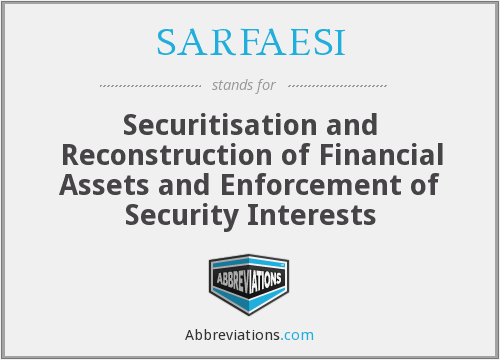In this article, Prashant Motsara, pursuing B.A.LL.B(Hons) from The National University of Advanced Legal Studies, Kochi, discusses the summary of SARFAESI Act Amendments, introduced in 2016.
SARFAESI Act Amendments
The Securitisation and Reconstruction of Financial Assets and Enforcement of Security Interests Act, 2002 or SARFAESI Act Amendments have been made in 2016 because of “Enforcement of Security Interest and Recovery of Debts Laws and Miscellaneous Provisions (Amendment) Act, 2016”. It was a change long awaited. The act added new definitions to SARFAESI, widened the scope of debts and secured creditors and bestowed upon RBI new powers in relation to making of policies.
Definitions
- Definition of “ARC” added. A company registered with RBI for the purpose of securitisation and asset reconstruction.
-
Definition of “Borrower” expanded by adding funds raised by him by way of issuance of debt securities1.
-
Definition of “Debt” expanded by adding unpaid portion of purchase or any right/title/interest on unpaid portion.
-
Definition of “Default” expanded by including defaults regarding debt securities. However, a 90 day notice for payment has to be given in such case.
-
Definition of “Financial Assistance” expanded by including funds provided for acquisition of tangible assets on hire/financial lease/conditional sale/contract/assignment/purchase of debt securities.
-
Definition of “Financial Asset” is expanded by adding beneficial right, title or interest in any tangible property given on hire/conditional sale/contract which secures the obligation to pay any unpaid portion of purchase price. Any right, title or interest on any intangible asset or license or assignment of such intangible asset, which secures the obligations to pay any unpaid portions of purchase.
-
Definition of “Financial Institution” is expanded by adding ARC and debenture trustee appointed for debt securities and registered with board.
-
Definition of “Financial Lease” added. It means a lessor’s right in a tangible asset under a lease where at the expiry of lease or upon such payment, the lessee becomes the owner of the asset.
-
Definition of “Negotiable Document” added. It means a document which embodies a right to delivery of tangible assets and satisfies the requirements for the negotiability under any law for the time being in force including warehouse receipt and bill of lading.
-
Definition of “Property” now includes intangible assets, being know-how, patent, trademark, copyright, license, franchise, any other business or commercial right of similar nature.
-
Definition of “Qualified Institutional Buyer” expanded by adding any other category of non-institutional investors specified by RBI.
-
Definition of “Secured Creditor” expanded by adding – holding right title or interest upon financial asset, bank appointed debenture trustee, ARC, debenture trustee registered with SEBI and appointed by company, any other trustee holding securities on behalf of a bank
-
Definition of “Security Interest” has been amended but it isn’t a substantial change.
Registration of ARC
-
The earlier prerequisite for ARC to hold fund not exceeding 15% of total financial asset acquired or to be acquired by company is removed.
-
The earlier condition for sponsor not to be a holding company of ARC is replaced with a sponsor, fit and proper in accordance with guidelines of RBI.
-
Mandatory to take RBI’s approval for appointment of director/managing director/chief executive manager of ARC.
-
Exemption from stamp duty on documents given by banks to ARC for the purpose of securitisation. Also, all rights and interest regarding the unpaid portion which was held by bank earlier, will vest with ARC.
-
Measures to be taken for asset reconstructions are same. However, ARC will have to act according to the directions and policies formulated by RBI. RBI to also release policies for fee charged/incurred by ARC or transfer of security receipts issued to qualified buyers.
-
RBI can conduct audits and inspections of ARC and can remove chairman, appoint additional director or observer in case it finds the functions against public interest.

Enforcement of Security
-
Proviso added to section 13(2) – buyer need not classify NPA in case he has raised funds through debt securities. Upon default, he can enforce under this section.
-
Section 13(8) – earlier dues could be paid till sale or transfer. Now it can be paid till the date of auction/publication of notice. The time period for the borrower to make the payment has been reduced considerably.
-
DM/CMM has to pass order for taking possession of the secured assets within 30 days. He is allowed to extend the period by another 30 days but he will have to record reasons for the same.
-
Manner and effect of takeover of management remains unaltered. However, a proviso is added which states that in case where ARC/secured creditor/financial institution converts debt into equity and enjoys controlling power over the management of Borrower Company, it will not be liable to restore the management of the borrower.
-
The earlier provision of “Appeals” has been renamed as “Application against measures to recover secured debts”. DRT has been conferred powers in case where a person claims tenancy or leasehold rights under this application to see whether lease has expired, whether it is contrary to section 65A of TOPA, whether it is contrary to terms of mortgage or whether it was created after issuance of notice under 13(2).
-
Government has the power to integrate registration records under various registration systems.
-
The time limit of 30 days to file particular of securitisation, Asset reconstruction or creation of security interest with CERSAI has been done away with.
New Chapter IVA
-
The provisions of this chapter are extended to all creditors except secured creditors for creation, modification or satisfaction of any security interest.
-
All creditors including secured creditors may file particulars of transactions with central registry.
-
Creditors other than secured creditors not eligible to exercise right of enforcement of securities under this Act.
-
Government and its authorities which have claims of recovery of tax or order of attachment, it has to be registered with Central Registry.
-
Any person having order of attachment against the borrower shall file such order with Central registry.
-
Such registration will be deemed to be public notice from the date of filing with the Central Registry.
-
Secured creditor and creditors holding order of attachment shall have priority over all subsequent security interest created upon such property and any transfer by way of sale, lease or assignment or license of such property or attachment order subsequent to such registration.
-
Exception – nothing mentioned above applies to transactions carried on in ordinary course of business.
-
No secured creditor shall be allowed to exercise right of enforcement of securities under chapter III unless the security interest created has been registered with the Central Registry.
-
Secured creditor to have priority over other debts, revenues, taxes, cesses and other rated payable to government and local authority.
-
In cases where the proceeding are under IB Code, the priority will be according to the code.
Penalties
-
Failure to comply with RBI directions – Adjudicating authority to serve notice and give reasonable opportunity to other party to represent. Any penalty imposed has to be paid within 30 days and the Adjudicating authority2 has the power to cancel the registration of ARC.
-
Appeal against the penalty can be made within 30 days Appellate Authority.
-
RBI to appoint Appellate Authority.
-
Recovery of Penalties –
Penalty is a recoverable sum and if it is not paid in 30 days, the following actions can be taken by RBI –
-
-
Debit the current account.
-
liquidate the securities held to the person in default in the books of RBI.
-
Notice to debtor of the person in default of payment of penalty and demand payment.
-
Such notice will be binding on the person upon whom it is issued.
-
Any claim arising after the date of issuance of notice will be void.
-
Where person upon whom notice is served issued a statement on oath that the amount or part of the amount is actually not due, RBI cannot claim such amount.
-
In case such statement is found to be false, he will be personally liable to pay to RBI such amount as mentioned in notice or the amount actually owed to the other person, whichever is less.
-
RBI can enforce the recoverable sum through Principal Civil court having jurisdiction in the area where the registered office or the head office or the principal place of business of the person in default or the usual place of residence of such person is situated as if the notice issued by the Reserve Bank were a decree of court.
-
-
Section 31 and 32
-
Section 31 – “Provision of the act not applicable”.
Sub clause (e) – any conditional sale, hire, pruchase or lease or any other contract in which no security interest has been created is omitted.
-
Section 32 – “Protection of action in good faith”.
Earlier the protection was only available for secured creditors and his officer and managers. Now it is available to RBI and Central Registry as well.
1Debt Securities – It is defined in regulation 2(1)(e) of Securities and Exchange Board of India (Issue and Listing of Debt Securities) Regulations, 2008 as – non convertible debt securities which create or acknowledge indebtedness and include debenture, bonds and such other securities of a corporate or any statutory body constituted by virtue of legislation, whether constituting a charge on the assets of the body corporate or not but excludes bonds issued by government and such other bodies as may be specified by Board, security receipts and securitised debt instruments.
2Adjudicating Authority means such officer or a committee of officers of the Reserve Bank, designated as such from time to time, by notification, by the Central Board of Reserve Bank.
LawSikho has created a telegram group for exchanging legal knowledge, referrals and various opportunities. You can click on this link and join:
https://t.me/joinchat/J_
 Serato DJ Crack 2025Serato DJ PRO Crack
Serato DJ Crack 2025Serato DJ PRO Crack










 Allow notifications
Allow notifications




all new added changes was make for benefitting bank,house,defaulter etc. there is no any law which is helping person who is buying auction property with risk or with confussion of process. need atleast safty of his life & family memeber as there is always dispute betwwen them. also all proecss & laws of act was transperent .defaulter enjoying house togeather with bank person relation, so bank can not sell property for nation development.call me if u want discuss on 9099900950